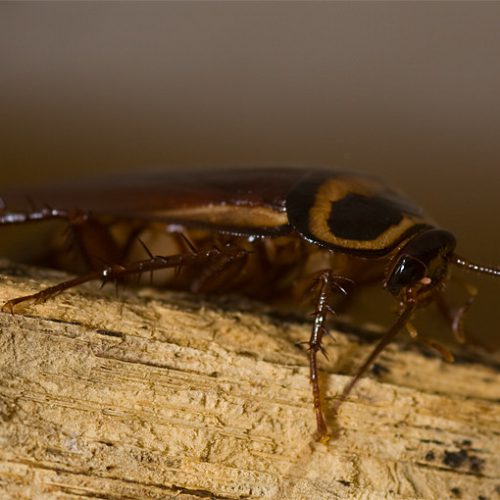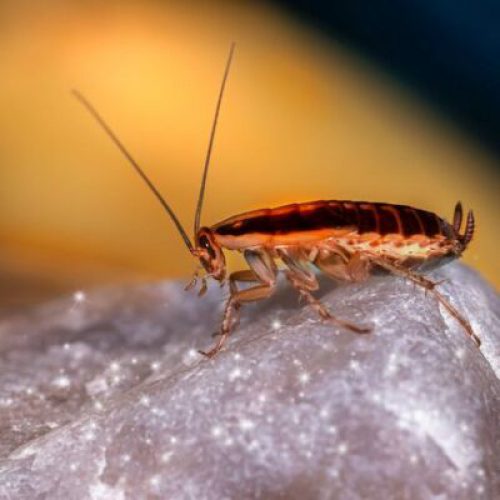Cockroaches from Australia and America are the familiar large cockroaches commonly found indoors. These cockroaches can grow as big as 40-60mm, about 4 or 5 times larger than the German cockroach. Australian cockroaches are also able to fly. Their pattern is brown with yellow head markings.
Cockroaches can enter homes through small cracks, windows, holes, and doors. Cockroaches do a lot of moving inside the home and regularly clean their feet; this is the ideal time for them to ingest chemicals. Cockroaches most commonly die to residual chemicals left around skirting boards and kick plates. They like to travel on surfaces, such as walls and floors, so the skirting board between areas is a great space for chemical application.
Cockroaches do not die instantaneously. Many insect repellant commercials give the impression that cockroaches die quickly and easily, which simply isn’t the case. Because of the myths and misunderstandings related to cockroach treatments, it’s important to search for a reliable and reputable pest control expert. A company that is fully qualified and insured is ideal for cockroach treatments. Below, for example, are some of our meeting points that are brought forward with technicians regularly:
- The first priority of any pest control treatment is to know what the problem is. This requires talking to the client to gauge the extent of their particular concerns, as well as the extent of the infestation they have reported (if they have reported any signs). This also facilitates a conversation about the type, and amount, of chemicals that may be needed for treatment.
- A good technician must be aware of the fact that, although some chemicals are labelled for control of various pests, they do not always have the same effect on these pests. In some cases, chemicals may not be effective at all. Only trials and observation will show which chemicals are suitable for a situation, and all technicians should use this evidence-based approach when deciding from a broad spectrum of chemicals treatment.
- With Australian/American cockroaches, the most common areas of infestation are:
- Below sink cupboards
- Bath cavities
- Wall cavities
- Fridges
- Dishwashers
- Washing machines
- Underneath concrete slabs (skillion areas, carports, etc)
- Brick veneer cavities near kitchens and bathrooms
- Roof voids
- A pest inspection will uncover entry and access areas that the cockroaches have been using to get inside the house. The aim of treatment is to access these areas as unobtrusively as possible in order to treat the infestation at its source. The area below sinks is best accessed by lifting the cover plate on the sink downpipes; if this is not possible with a heavy infestation, however, then it may be required to drill small holes (3-5mm) into some areas. Areas that might require drilling include kick board shadow lines, hidden or concealed bath sides, and other small tucked away areas. These holes are used to inject Coopex dust or an aerosol flushing agent in order to eradicate any breeding nests the cockroaches have built.
- Technicians will examine the exterior of the property for any piping through the walls where the smallest gaps can be susceptible to infestation. Any concrete slabs on the ground are also assessed for cracks and breakages, as well as raised areas where the concrete meets soil (a hot spot for cockroach nests). These areas are treated accordingly with a puffer or dust blower specialised for gaps and cracks.
- Cockroaches can also be found in ceiling cavities and highly concealed or dirty areas. Technicians will search around for dark hiding locations, such as garden sheds, areas where a lot of accumulated goods are stored (junk inside a shed or under a house, for example), as well as anywhere there are concrete slabs or patios. These areas are easily secured with 50 grams of pyrethrin dust applied with a blower.
- Finally, all other areas must also be thoroughly assessed and treated for signs of infestation. This includes subfloor or bar areas outside, barbecue areas, areas with a build up of junk, any any sheds or garages. Treatment remains the same, and applied aerosol or regard with the blower will clean these areas of any cockroaches.
German cockroaches are generally brought into a home through packaging, drawn to dark areas and then exploring the property in search of food and water. When German cockroaches die, they drop an egg casing that holds anywhere between 20 and 40 baby cockroaches. These babies hatch in around three weeks and the young shed their shells approximately 7 times as they fully mature. This debris is often seen around the home three weeks after hatching, indicating a German cockroach infestation. Dunrite uses a growth regulator when treating German cockroaches, which stops the young from shedding their shells and ultimately eliminates them.
A treatment for German cockroaches can take up to six weeks due to their life cycle, egg casing, and shedding habits. Three weeks following treatment, there will generally be an alarming amount of baby cockroaches around the home but don’t be worried; they will die! It is recommended not to mop the floor with any treatment for at least three weeks to get the best results.
Get a Quote
Need a FAST & FREE quote? Our friendly team can provide on-the-spot quotes for many treatments, including pest control or termite inspections.
A technician can also complete a free mould remediation quote or free quote for a termite barrier (30 minute consultation). Click the link below or call us on 1300 737 378!


